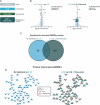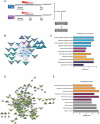This is a preprint.
Effective xanthine oxidase inhibitor urate lowering therapy in gout is linked to an emergent serum protein interactome of complement activation and inflammation modulators
- PMID: 38766125
- PMCID: PMC11100878
- DOI: 10.21203/rs.3.rs-4278877/v1
Effective xanthine oxidase inhibitor urate lowering therapy in gout is linked to an emergent serum protein interactome of complement activation and inflammation modulators
Update in
-
Effective xanthine oxidase inhibitor urate lowering therapy in gout is linked to an emergent serum protein interactome of complement and inflammation modulators.Sci Rep. 2024 Oct 19;14(1):24598. doi: 10.1038/s41598-024-74154-5. Sci Rep. 2024. PMID: 39426967 Free PMC article. Clinical Trial.
Abstract
Background: Urate-lowering treatment (ULT) to target with xanthine oxidase inhibitors (XOIs) paradoxically causes early increase in gouty arthritis flares. Because delayed reduction in flare burden is mechanistically unclear, we tested for ULT inflammation responsiveness markers.
Methods: Unbiased proteomics analyzed blood samples (baseline, 48 weeks ULT) in two, independent ULT out trial cohorts (n = 19, n = 30). STRING-db and multivariate analyses supplemented determinations of altered proteins via Wilcoxon matched pairs signed rank testing in XOI ULT responders. Mechanistic studies characterized proteomes of cultured XOI-treated murine bone marrow macrophages (BMDMs).
Results: At 48 weeks ULT, serum urate normalized in all gout patients, and flares declined, with significantly altered proteins (p < 0.05) in clustering and proteome networks in sera and peripheral blood mononuclear cells. Serum proteome changes included decreased complement C8 heterotrimer C8A and C8G chains and chemokine PPBP/CXCL7, and increased urate crystal phagocytosis inhibitor sCD44. In both cohorts, a treatment-emergent serum interactome included key gouty inflammation mediators (C5, IL-1B, CXCL8, IL6). Last, febuxostat inhibited complement activation pathway proteins in cultured BMDMs.
Conclusions: Reduced gout flares are kinked with a XOI-treatment emergent complement- and inflammation-regulatory serum protein interactome. Serum and leukocyte proteomes could help identify onset of anti-inflammatory responsiveness to ULT in gout.
Trial registration: ClinicalTrials.gov Identifier: NCT02579096, posted October 19, 2015.
Keywords: C8; Complement; TGFbeta; Xanthine oxidase; allopurinol; febuxostat; gout; inflammation; proteomics.
Conflict of interest statement
Competing interests: DJG: Grant from Janssen Pharmaceuticals RT: Dr. Robert Terkeltaub has recently served, or currently serves, as a consultant for Allena, LG Chem, Fortress, Selecta Biosciences, Horizon Therapeutics, Atom Bioscience, Acquist Therapeutics, Generate Biomedicines, Astra-Zeneca, and Synlogic, and was a previous recipient of a research grant from AstraZeneca. He serves as the non-salaried President of the G-CAN (Gout, Hyperuricemia, and Crystal-Associated Disease Network) research society, which annually receives unrestricted arms-length grant support from pharma donors. The other authors declare that they have no conflict of interest.
Figures



Similar articles
-
Effective xanthine oxidase inhibitor urate lowering therapy in gout is linked to an emergent serum protein interactome of complement and inflammation modulators.Sci Rep. 2024 Oct 19;14(1):24598. doi: 10.1038/s41598-024-74154-5. Sci Rep. 2024. PMID: 39426967 Free PMC article. Clinical Trial.
-
Sustained xanthine oxidase inhibitor treat to target urate lowering therapy rewires a tight inflammation serum protein interactome.Res Sq [Preprint]. 2024 Jan 2:rs.3.rs-3770277. doi: 10.21203/rs.3.rs-3770277/v1. Res Sq. 2024. Update in: Sci Rep. 2024 Oct 19;14(1):24598. doi: 10.1038/s41598-024-74154-5. PMID: 38260556 Free PMC article. Updated. Preprint.
-
Xanthine oxidase inhibitor urate-lowering therapy titration to target decreases serum free fatty acids in gout and suppresses lipolysis by adipocytes.Arthritis Res Ther. 2022 Jul 25;24(1):175. doi: 10.1186/s13075-022-02852-4. Arthritis Res Ther. 2022. PMID: 35879786 Free PMC article.
-
Cardiovascular Safety of Urate Lowering Therapies.Curr Rheumatol Rep. 2019 Jul 24;21(9):48. doi: 10.1007/s11926-019-0843-8. Curr Rheumatol Rep. 2019. PMID: 31342190 Review.
-
[Gout management: an update].Ther Umsch. 2016;73(3):115-24. doi: 10.1024/0040-5930/a000766. Ther Umsch. 2016. PMID: 27008442 Review. German.
References
Publication types
Associated data
Grants and funding
LinkOut - more resources
Full Text Sources
Medical
Miscellaneous

